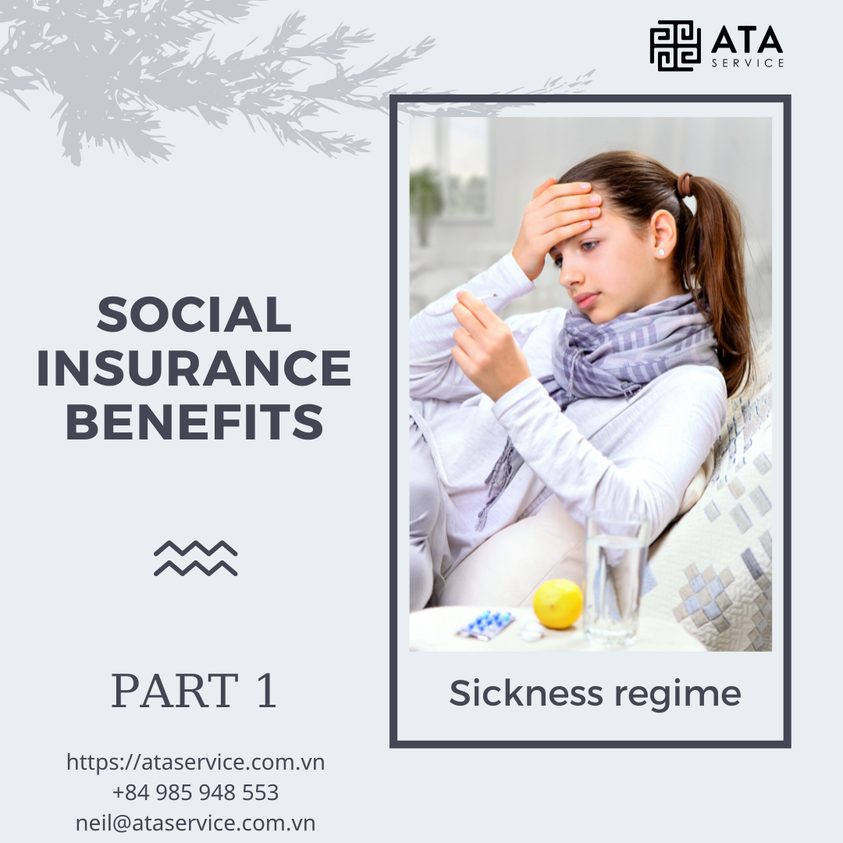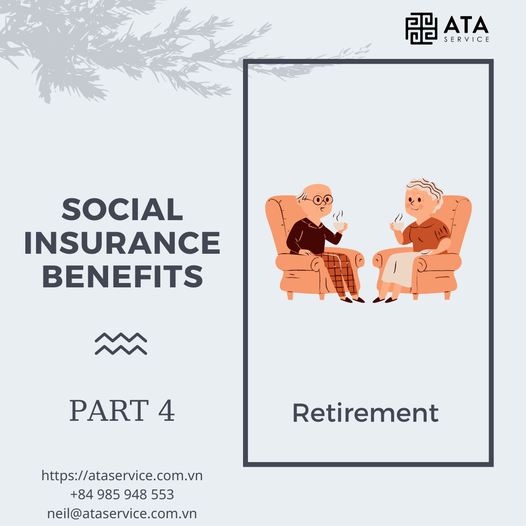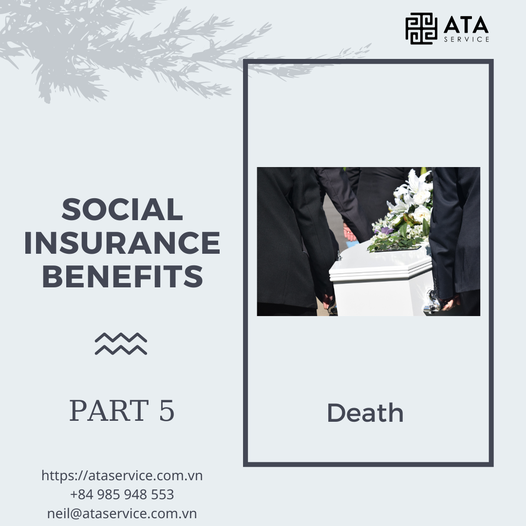SOCIAL INSURANCE BENEFITS
Benefits of participating in social insurance contributions:
1. Sickness regime
2. Maternity mode
3. Occupational accidents and diseases
4. Retirement
5. Death

1. SICKNESS REGIME
a. Condition
When an employee suffers an illness or an accident that is not an occupational accident, he/she must take leave from work and have the certification of a competent medical examination and treatment facility, he/she will be entitled to the sickness regime.
In case of illness or accident and must take leave from work due to self-destruction of health, drunkenness or use of narcotics or drug precursors according to the list prescribed by the Government, they are not entitled to the sickness regime.
In addition, in case they have to take time off from work to take care of their sick children under 07 years old and certified by a competent medical facility, they are also entitled to this sickness regime.
b. Time to enjoy sickness benefits
For ordinary employees: The maximum time to enjoy the sickness benefits in a year for employees is calculated by working days excluding public holidays, New Year holidays, and weekly rest days and is regulated as follows:
+ Enjoy 30 days if you have paid social insurance for less than 15 years
+ 40 days if paid from full 15 years to less than 30 years
+ 60 days if paid for full 30 years or more
For employees who do heavy, hazardous or dangerous occupations or jobs or especially heavy, toxic or dangerous jobs on the list promulgated by the Ministry of Labor, War Invalids and Social Affairs, the Ministry of Health, or Working in a place with a regional allowance coefficient of 0.7 or more, they are entitled to the following:
+ 40 days if you have paid social insurance premiums for less than 15 years
+ 50 days if paid from full 15 years to less than 30 years
+ 70 days if paid for full 30 years or more.
Employees who take leave due to illness on the List of diseases requiring long-term treatment promulgated by the Ministry of Health are entitled to a maximum of 180 days, including public holidays, New Year holidays and weekly rest days. At the end of the sickness benefit period, if the employee continues to receive treatment, he or she will continue to be entitled to the sickness benefit at a lower rate, but the maximum benefit period is equal to the period of payment of social insurance premiums.
In case the employee takes leave to take care of a sick child under 07 years old, the period of enjoying the sick child benefit in one year for each child is calculated according to the maximum number of child care days, which is 20 working days if the child is sick. under 03 years old; maximum is 15 working days if the child is from full 03 years old to under 07 years old.

2. MATERNITY MODE
a. Subject
An employee is entitled to the maternity regime in one of the following cases:
Pregnant female employees;
Female employees giving birth;
Female employees as surrogate mothers and mothers asking for surrogacy;
The employee adopts a child under 6 months old;
Female employees use IUDs, employees use sterilization measures;
Male employees who are paying social insurance premiums whose wives give birth to children.
b. Eligibility conditions
Employees must pay social insurance contributions for full 06 months or more within 12 months before giving birth or adopting a child.
An employee who has paid social insurance premiums for full 12 months or more but has to take a leave of absence from work to take care of the pregnancy when she is pregnant under the direction of a competent medical examination and treatment facility shall have to pay social insurance premiums for a full 03 months or more during the period. 12 months before giving birth.
In case the employee has fully met the conditions, but terminates the labor contract, the working contract or quits before the time of giving birth or adopting a child under 6 months old, he/she is still entitled to the maternity regime.
c. Time to enjoy
Pregnancy check-up: During pregnancy, female employees are entitled to take leave from work to go for prenatal check-ups 05 times, 01 day each time; If the patient is far from medical examination and treatment establishments or the pregnant woman has a medical condition or an abnormal pregnancy, she is entitled to 2 days off for each antenatal care visit.
In case of miscarriage, curettage, abortion, stillbirth or pathological abortion, female employees are entitled to take maternity leave as prescribed by competent medical examination and treatment establishments. The maximum time off work is regulated as follows:
– 10 days if the pregnancy is under 05 weeks;
– 20 days if the pregnancy is from 05 weeks to under 13 weeks;
– 40 days if the pregnancy is from 13 weeks to under 25 weeks;
– 50 days if the pregnancy is 25 weeks or more.
Giving birth: they are entitled to the maternity regime before and after giving birth for 6 months. If the mother has twins or more, from the second child onwards, for each child, the mother is entitled to an extra month of leave.
The wife gives birth to a child: male employees who are paying social insurance contributions will be entitled to 5 working days off. If you have a cesarean section or your baby is under 32 weeks old, you will be entitled to 07 days of leave. In case the wife gives birth to twins, she is entitled to 10 working days off, from the birth of triplets or more, for each additional child, she is entitled to an additional 03 working days. If the wife gives birth to twins or more, she is entitled to 14 working days off
The child dies after giving birth: if the child under 2 months old dies, the mother is entitled to a 4-month leave from the date of birth; If a child aged 2 months or older dies, the mother is entitled to a 2-month leave from the date of the child’s death, but the time off work to enjoy the maternity regime must not exceed 6 months.
+ If the mother dies after giving birth, the father or the person directly raising the child is entitled to take a leave of absence to enjoy the maternity regime for the remaining time of the mother.
Surrogacy birth: Female employees who are surrogate mothers are entitled to benefits upon antenatal care, miscarriage, abortion, abortion, stillbirth or pathological abortion, and benefits upon childbirth until the time of handing over the child to the mother. by surrogacy.
+ In the case that from the date of birth to the time of delivery of the child, the maternity leave period is less than 60 days, the surrogate mother is still entitled to the maternity regime until full 60 days including holidays. Tet holiday, weekly rest day.
+ The mother who asks for surrogacy is entitled to the maternity regime from the time of receiving the child until the child is full 6 months old.
Adoption: enjoy until the child is full 06 months old.
Contraception: 07 days off for female employees who have an IUD or 15 days for employees who undergo sterilization.
d. Maternity benefits:
The monthly allowance is equal to 100% of the average monthly salary on which social insurance premiums are based for the 06 months before taking leave to enjoy the maternity regime.

3. OCCUPATIONAL ACCIDENTS AND OCCUPATIONAL DISEASES
a. Conditions for enjoying the occupational accident regime
Employees are entitled to the occupational accident regime when meeting all conditions such as having an accident at the workplace and during working hours; Outside the workplace or outside working hours when performing work at the request of the employer or on the route to and from the place of residence to the place of work within a reasonable time and route. In addition, the accident sufferers must have their working capacity reduced by 5% or more due to the accident to be entitled to this regime.
b. Conditions for enjoying the occupational disease regime
Employees are entitled to the occupational disease regime when suffering from an illness on the list of occupational diseases promulgated by the Ministry of Health and the Ministry of Labor, War Invalids and Social Affairs when working in a hazardous environment or occupation. assessors suffer from a decrease in working capacity of 5% or more due to illness.
c. Benefit level
When an employee has a working capacity decrease of 5% to 30%, he/she is entitled to a lump-sum allowance equal to 5 times the base salary, then for every additional 1% decrease, he/she will be entitled to an additional 0.5 times the salary. basis;
+ In addition, employees are also entitled to an additional allowance calculated according to the number of years of payment of social insurance premiums, from one year or less, it is calculated as 0.5 months, then for each additional year of payment of social insurance, an additional 0.3 is calculated. month of salary paid for social insurance of the month immediately preceding the leave of absence for treatment.

4. RETIREMENT
a. Condition
Employees who have retired from work have fully paid social insurance for 20 years or more
Full 60 years old for men, full 55 years old for women;
If you have had full 15 years of working in a heavy, hazardous or dangerous occupation or job or an especially heavy, hazardous or dangerous job on the list promulgated by the Ministry of Labor, War Invalids and Social Affairs and the Ministry of Health, Male requirements are from full 55 to full 60 years, women from full 50 to full 55 years.
Having full 15 years of working as a coal miner in a pit, from full 50 years old to full 55 years old (regardless of male or female).
If working capacity is reduced by 61% or more, from January 1, 2016, men will be full 51 years old and women will be full 46 years old. Then each year increase by one year until 2020, when men reach 55 years old and women reach 50 years old, they are eligible for pension.
b. Benefit level
Before 2018: calculated as 45% of the average monthly salary of social insurance, corresponding to 15 years of payment of social insurance, then for each additional year, 2% for men and 3% for women; up to 75%.
From January 1, 2018 the monthly pension is calculated at 45% of the average monthly salary of social insurance, corresponding to the number of years of payment of social insurance. For men, it is from 16-20 years, for women, for 15 years, then every year. year, 2% for men and 3% for women; up to 75%.
In addition, the level of pension enjoyment when having a working capacity decrease or a one-time allowance is regulated by the Law on Social Insurance 2014.

5. DEATH
When an employee dies, his or her relatives or people in charge of the funeral will be entitled to a funeral allowance, a monthly survivorship allowance and a one-time survivorship allowance.
The specific benefits are as follows:
+ Funeral allowance: relatives of deceased employees will be entitled to 10 times the base salary
+ Monthly survivorship allowance: The monthly survivorship allowance for each relative is equal to 50% of the base salary; In case the relative has no person to directly take care of, the monthly survivorship allowance is equal to 70% of the base salary.
+ One-time survivorship allowance: when the employee’s relatives wish to receive this benefit once and are not eligible for the monthly survivorship allowance, it will be calculated as 1.5 months of the average monthly salary. pay social insurance premiums (before 2014) and equal to 02 months of the average monthly salary on which social insurance premiums are based for the years of 2014 onwards; the lowest level is equal to 03 months of the average monthly salary on which social insurance premiums are based.
